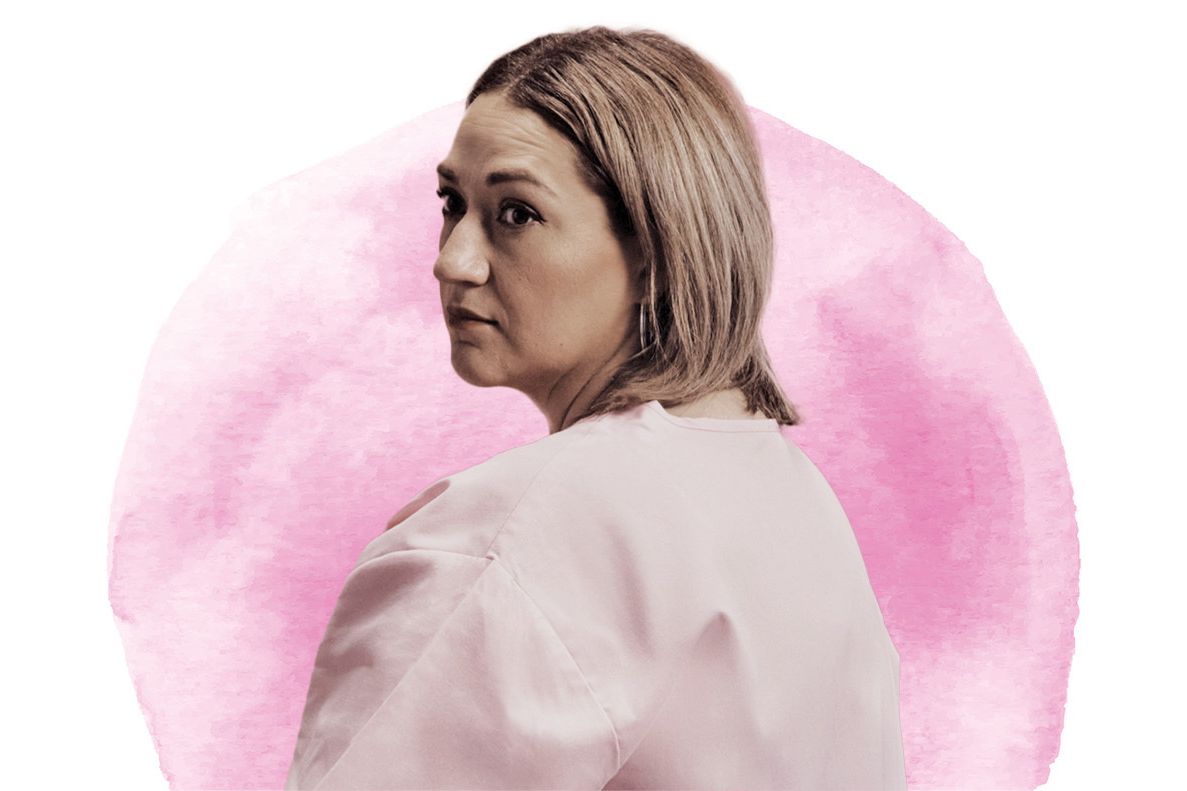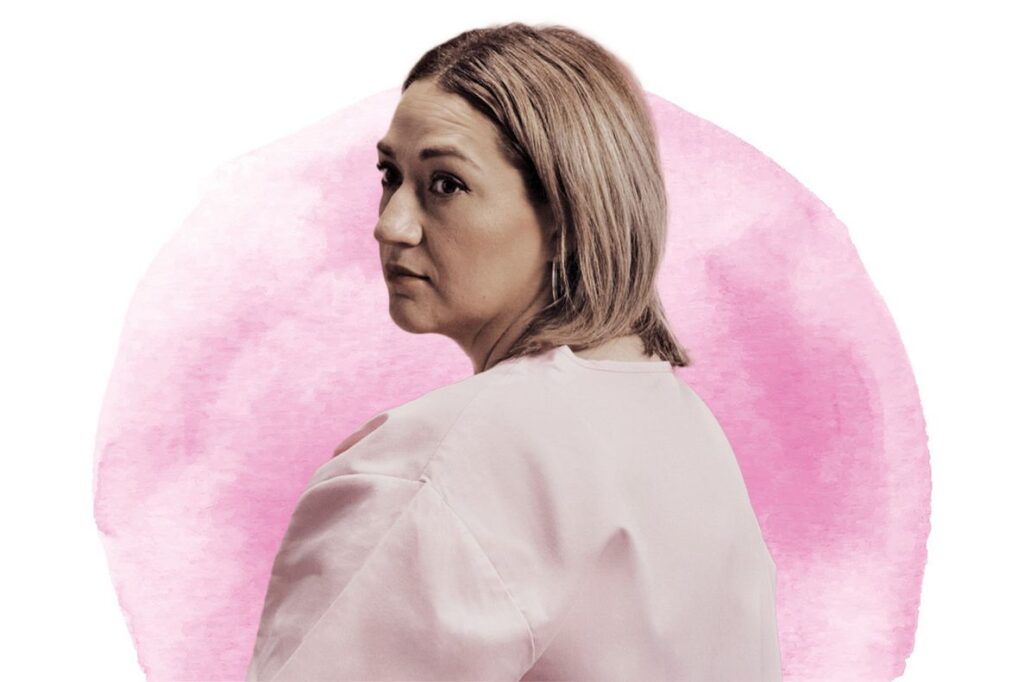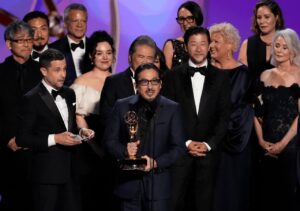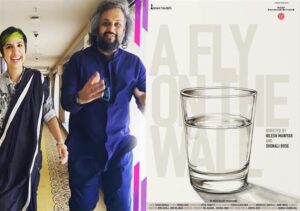
In April 2022, Clara Hochhauser, a nurse who works the labor-and-delivery floor at the University of Illinois Hospital, came in to have her own baby when the unthinkable happened. The anesthesiologist on call failed to administer the proper painkillers, and despite her protestations, she was forced to feel every moment of her Cesarean section: blade cutting the abdomen open, hands retrieving the babies (she had twins), uterus lifted out of her body (“exteriorized,” in medical parlance), organ returned, skin stitched shut.
The second season of The Retrievals opens with Clara’s experience, but it takes a moment to grasp how it’s going to tell the story. “Six a.m. in Chicago,” begins Susan Burton, who returns as host and lead reporter. “Of course, the shot starts at the lake. Camera pans over the water, and the magnificent buildings rise from the shoreline.” Burton continues in this self-aware, vaguely noir register as she introduces Clara, another nurse named Mindy Figueroa (pictured above), and Heather Nixon, the head of obstetric anesthesia at the hospital. “ The action of the episode begins with Mindy in a nearly empty elevator,” she continues. “Closer to 7 a.m. Change of shift. You can barely fit. Sardines. But Mindy’s early today. She’s almost always early.” Gradually, the season’s stylistic gambit comes into focus. Burton is presenting the story as if it were a medical procedural or, more precisely, narrating it as if describing a TV medical procedural about the very real events she’s reporting: “A humble hospital in Chicago. A hardworking nurse. A delivery with stakes. How could we not tell this like a medical drama?”
At first, the choice feels peculiar. It’s a heavier, flashier touch than the show’s first season, which chronicled a case at the Yale Fertility Center in Connecticut, where, in 2020, a nurse regularly stole fentanyl solution and left dozens of women to undergo egg retrievals without painkillers. That story isn’t about the nurse so much as the patients who saw their excruciating pain systematically ignored, and Burton conveys them as a kind of Greek chorus, individual voices cycling in and out to conjure a sense of collective experience. It works right off the bat. In contrast, season two’s meta-genre framing initially comes off as distracting — that is, until the opening episode gets to Clara’s C-section. This is when the detached procedural style begins to pay dividends: It gives listeners just enough distance to stay close to the unbearable.
Burton produces the season with Serial co-creator Julie Snyder and Ben Phelan, who worked on last season, and together they build a natural extension of The Retrieval’s project. The first outing focused on one nurse’s misconduct to explore how women’s firsthand experiences of medical pain are routinely dismissed by hospitals, the justice system, and often the women themselves. Burton is particularly interested in the nuances of what this systematic dismissal means; one of her more pointed provocations revolves around how motherhood is often privileged in ways that undermine the literal well-being of women. Season two expands upon Burton’s investigation by shifting the focus to that same dismissal as it occurs during C-sections, the most common major surgery in the world. What Clara endured is an aberration, but Burton draws attention to how cultural norms around pregnancy suppressed Clara’s ability to successfully communicate what was happening to her. Pregnancy is broadly understood to involve a vast spectrum of pain even when things go “right,” from first-trimester nausea to vaginal delivery to postpartum depression, so when something goes wrong, even terribly, it can be shrouded by the assumption that it’s all part of the deal. Childbirth is supposed to be painful. She’s just being anxious.
Burton was tipped to this phenomenon by listeners who wrote in describing anesthesia failures during their own C-sections, which prompted her to discover the unsettling reality that not only are such failures more common than expected, but they remain largely unexamined. She cites one figure, 8 percent, from a forthcoming study that, remarkably, is the first of its kind. Using Clara’s story as a central pillar, she sets off to trace a fragmented but determined effort by people around the world working to solve the problem. No small feat, as the underlying challenge is how to enact cultural and institutional change within the medical Establishment.
What transpires is a four-part season that’s striking though somewhat uneven. After the wrenching opener, the episodes pivot into more technical territory. The second installment partly concerns a medical conference where Heather, the hospital’s head of obstetric anesthesiology, presents her findings, while the third focuses on a British woman named Susanna Stanford who, after her own traumatic C-section, becomes an advocate whom a group of medical researchers recruit to help shape a seminal study on the matter (even though she’s not a doctor). These middle chapters resemble traditional science reporting, and the medical-drama framing proves useful in a different way. If its function in the premiere is to soften the blow, its role here is to lend cinematic weight to what might otherwise feel like dry, procedural detail. Conferences don’t naturally make for compelling tape.
But there’s a deeper purpose to the framing device that Burton saves for the end. The fourth and final installment returns to the University of Illinois Hospital, where Burton documents how the labor-and-delivery floor is attempting to change its approach to identifying and managing women’s pain — and just how difficult that is to do. We learn that Burton was hoping to record a C-section, intending to observe how the medical team handled the administration of anesthesia. She’s given the opportunity to go into a live operation, but the patient provides permission only at the last minute, after the baby has been extracted. Burton talks about how it was nonetheless worthwhile for her to record because “there’s still a lot of surgery left” that requires anesthesia care, including stitching the patient’s abdomen closed. Her point is that changing systems and cultures isn’t just an intellectual task or a matter of implementing new policy. Addressing the dismissal of women’s pain requires not just technical fixes, like adjustments to medical training, protocols, and accountability structures, but also a shift in the more elusive realm of cultural understanding. That’s where the show’s genre framing loops back in: How we see medicine, pregnancy, and motherhood reflected in pop culture influences how we experience and interpret them in real life.
Not everything about the season lands. It’s hard not to leave the four episodes wishing for a little more insight into the day-to-day realities and institutional cultures that shape obstetric practice. Still, The Retrievals continues to be the rare narrative podcast that doubles as a case for why the format should exist. Clara’s experience of a botched anesthetic can be conveyed only through her voice. Onscreen, it would have been imprecise. On the page, it might read too clinically. In audio, the space left by the missing image draws you in. You build it in your mind. You work to feel it. And because you actively try to channel that experience, the hope is that it changes something in you too.
Related
In its second season, The Retrievals continues its exploration of how medical institutions routinely let women down.

































































